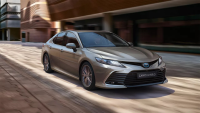The main indicator of well-being - the sedan is rapidly receding into history. Just 10-15 years ago, a medium-sized car with a separate trunk elevated its owner above the owners of small cars. But the ranks of these cars are noticeably shrinking, and almost half of their buyers are corporate clients, working in a cab. We have collected the most interesting representatives of this class - Toyota Camry and Mazda 6, and for the company took a brand-new Skoda Octavia with 2-liter turbo engine.
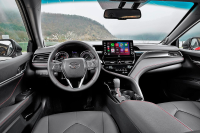
A reader-bookworm will certainly object. Like, it is impossible to compare cars of different classes. Octavia is the brightest representative of a segment C, but not D. Besides with the change of generations Skoda has kept the former chassis and length of wheelbase. But let's look at the cars closer. Yes, the Octavia is almost 20 cm less in length than the Camry, but in width - only 1 cm, and in space on a back sofa the difference is not so great. And the main thing is the prices. All our three rivals have similar capacity - from 190 to 200 hp, their configuration is almost maximal, and therefore they cost around 2,5 million rubles. Of course, we don't take into account dealer's markup, but there's parity here too: all three models are in great demand in the market, so the dealer will hardly give them away at the recommended price.
The burgundy and white interior is a sign of the anniversary Mazda 6.
Skoda is the freshest in our three, and therefore it has maximum screens.
In the course of the restyling, the Toyota display was raised above the dashboard, but the gauges remained analog.
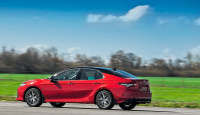
I suggest to leave cab services out of the equation. There is no consensus between our rivals here. Camry in "Comfort+" fare is very much loved for its smooth suspension and legendary reliability. Mazda 6 is practically not used in a cab, and Octavia is one step lower - it is simply "Comfort", without plus, which means the income will be lower. Moreover, to take the car with a turbo engine and DSG for daily standing in traffic jams is not a rational undertaking.
And to leave congestion aside and get pleasure from driving, let's go to ADM Raceway racetrack. These cars are unlikely to become regulars here, but the dominance of crossovers has accustomed a huge number of drivers to high seating and average handling in the corners, so I see only one reason to pay attention to a low sedan with not the most comfortable trunk right now - it's drive.
The weather in September was cold and damp, so, instead of pure power and declared dynamics the chassis settings and how it is easy to feel a car for a driver come out in the first place. And, of course, the scoreboard counts.
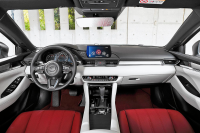
Let's start with the most controversial car - the Octavia. It has the most modest engine - only 190 hp, but thus it is promised acceleration up to a hundred for 7,4 seconds whereas Japanese make more than 8 seconds. How has it turned out so? All secret in a robotized gearbox DSG. Now it is with wet clutches that promises much more resource. However, you will have to dig in the multimedia screen to start well. It is far from the first time, but we still find deactivation of antiwheelspin system, and only then Launch Control mode is accessible. If you suddenly decide to chase someone, it is necessary to ask your rival for some time to prepare. Transmission in a sports mode, and now Skoda will make everything as Porsche 911. We press two pedals, the engine accelerates to optimum revolutions and... On a wet asphalt the front wheels helplessly grind not only on the first, but also on the second gear. We repeated these starts several times in a row, changing tracks, but the Mazda 6 starts from a place steadily more confidently. Probably it is helped by the proprietary system G-Vertoring Control, but with the same wheel slippage, the "six" always wins the start. However, as soon as the wheels find the support, which in our case happens at about 60 km / h, Skoda rushes in pursuit and has caught up to 100 km / h Japanese and confidently went ahead. Toyota Camry, despite of a small advantage in power, on the contrary, is the slowest on paper, but, having finished the drive, steadily keeps behind "Mazda". Closely related motors give very similar dynamics.
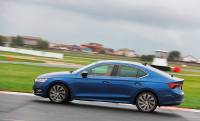
The most interesting thing happens in the corners. The tire width of all three rivals is the same - 225 mm, the only difference is the seating diameter: the Camry and Octavia have 18 inches, the Mazda has one inch more. But the behavior of the rivals is different. Skoda lets you skid as far as it has enough power, but at big angles of skidding it comes into action. It is safe and effective, but it is not very cheerful. Besides, when driving on the edge there is a sensation that Octavia is the increased in dimensions Volkswagen Golf. The handling isn't as good as you'd expect from a D-segment car. Mazda 6 disconnects electronics almost completely, and the driver is left alone with very burly chassis. You decided to frolic - be ready that you can be turned around if you make a mistake. If you are not sure - do not press the button ESP Off. Toyota is for those, who wants to live long, therefore slipping is supposed only up to 60 km/h, then electronics will be activated. The chassis itself, strangely enough, if also concedes Mazda, but a little. The last generation of the Samry has really learned to drive briskly, but nobody cancelled the philosophy of the company. And the comfort with which Toyota soars over the road is incomparable. On a track it passes curbs as if they don't exist, and on road it perfectly swallows road junctions and small holes. You can feel it even if you walk up to the car and try to rock it: it's much easier to do it on the Camry than on the Skoda or Mazda.
But no matter how much I enjoyed driving the Mazda around the track, it was unable to overtake the Octavia; the noticeable advantage in acceleration dynamics led the Skoda to victory. Although the difference was a ridiculous 0.3 seconds on a lap of more than 2 km, the scoreboard. The Toyota lost about 1 second to the Mazda, and that could well be explained by delays in the electronics. If we were driving on dry asphalt the loss of the Camry would be less, but for me the "six" is in the first place according to the pleasure of driving. Skoda is impressive in acceleration dynamics, but still inferior to the larger "Japanese" in the corners.
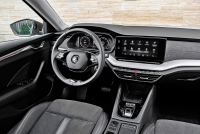
What to choose: Mazda 6, Skoda Octavia or Toyota Camry? We compared and drew conclusions.
There can be no two opinions on convenience of cargo transportation. Liftback body is noticeably more rational than a sedan. And 600 liters of useful volume are absolutely unattainable for competitors. Toyota has got a spare wheelbarrow and consequently without a hump in a luggage rack. The floor level of Camry is noticeably lower, than that of Mazda 6, and that means, Toyota will transport more things. But the first two generations of Mazda brought similar bodies to Russia, but they dared to localize only a sedan in Vladivostok, therefore we were deprived of all other variants.
For comfort of seating in rear the unequivocal leader is Toyota. It is surprising, because the Mazda 6 is even bigger in length of wheelbase, but it is more comfortable for rear passengers in Toyota. In expensive versions there is own climate control and even electric drive of backrests, but then you lose the possibility to fold seats and transport, for example, mountain skis. The "Octavia" also has its own microclimate unit, and at the same time a 220 volt outlet and curtains on the side windows. Mazda 6 is not less than Skoda in space, and its trimming is obviously more noble, especially in the version Century Edition with burgundy Nappa leather and the same color carpet on the floor. But there is only heating and charging for a cell phone among usual plushkas - it is hidden in the central armrest and is accessible only if there are two people sitting behind.
One can argue about comfort in the front endlessly. All three cars have own ideology, and each of them is beautiful in its own way. Mazda 6 fascinates with restraint and simultaneous richness of interior. For example, the digital dashboard is practically monochrome; color appears only when necessary. The Mazda is the only one among our three, which has a system of all-round vision and a projection on a windshield. But too modest screen of multimedia does not let it to win. Toyota is obviously trimmed simpler; even after restyling, it still has analog scales. But its soft seats set up for relaxed trip, which can go hours without a shadow of fatigue. However, the front passenger will have to regulate a seat with hands, whereas the "six" has electric actuators. Skoda is obviously focused on younger and impudent drivers, who did not choose the most powerful version by chance. Calm drivers have probably limited with a more modest motor and have received a fair automatic. Interior is like a motor. There is alcantara on seats, developed lateral support, instruments are completely digital, a touch strip instead of volume tilt wheel, and the block of the climate control is completely taken out to the screen of multimedia. To my taste, it is not optimum decision, which allowed the brand to economize on buttons, and the driver has to take his eyes off the road. But how well the armchairs hold in turns!
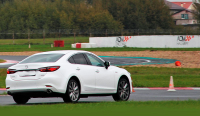
Despite the apparent similarity, the characters of all these cars are different. Skoda is fast and at the same time with a large luggage compartment. Toyota is as comfortable as possible both for the driver and the front passenger, and for those sitting in the back. A Mazda 6 is for those who like to drive and want to get real driver's pleasure from it.
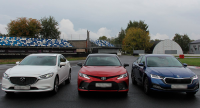
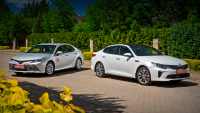
-rear-and-front-view-camera-6.png)
